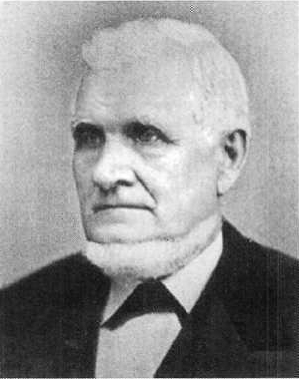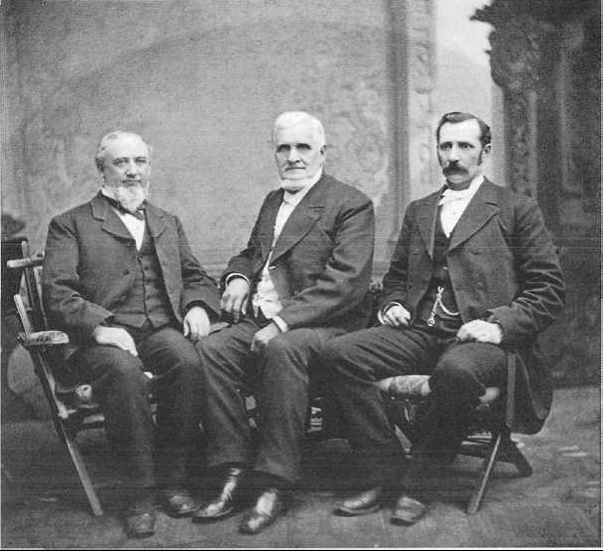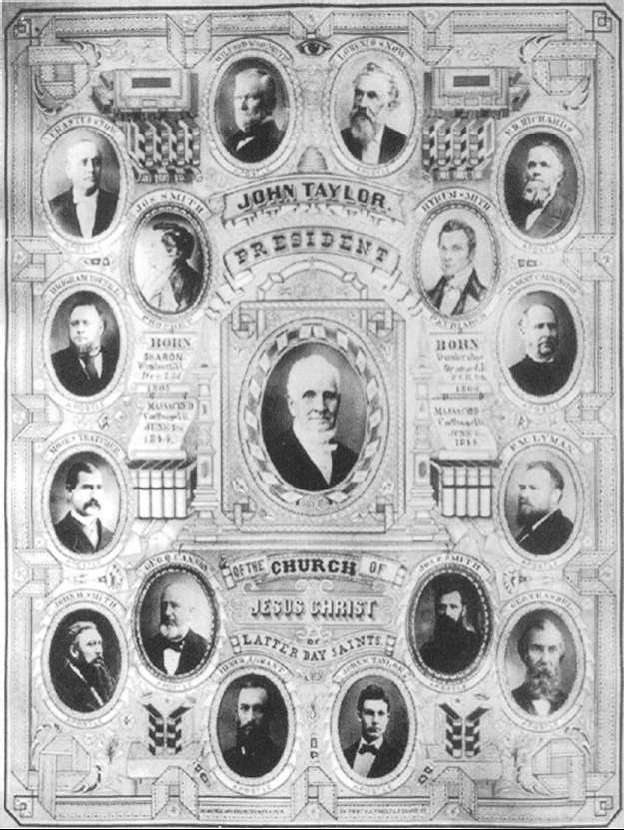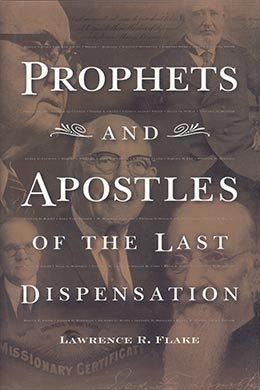John Taylor
Lawrence R. Flake, Prophets and Apostles of the Last Dispensation (Provo, UT: Religious Studies Center, Brigham Young University, 2001), 35–42.

Born: 1 November 1808, Milnthorpe, Westmoreland County, England
Quorum of the Twelve Apostles: 19 December 1838 (age 30)
President of the Quorum of the Twelve: 6 October 1877
President of the Church: 10 October 1880 (age 71)
Died: 25 July 1887 (age 78), Kaysville, Utah
A feeling of hostility permeated the crowd that was listening to Elder John Taylor of the Latter-day Saints at a public meeting in Columbus, Ohio. There were those in the audience who had come with the express design of tarring and feathering the young preacher. Although he knew of their evil intentions, he defied such threats by his bold appearance and his courageous discourse. Reminding his listeners that Canada, the country from which he had recently emigrated, was still under the control of a monarch, he praised the efforts of their American forefathers who gave their lives for freedom. He continued fearlessly: “By the by, I have been informed that you purpose to tar and feather me, for my religious opinions. Is this the boon you have inherited from your fathers? Is this the blessing they purchased with their dearest hearts’ blood—this your liberty? If so, you now have a victim, and we will have an offering to the goddess of liberty.” [1]
At this point the fearless young missionary threw open his vest and declared: “Gentlemen come on with your tar and feathers, your victim is ready; and ye shades of the venerable patriots, gaze upon the deeds of your degenerate sons! Come on, gentlemen! Come on, I say, I am ready!” [2] No one came forth, but Brother Taylor had shown his fine mettle—a talented orator, a persuasive logician, a courageous man unflinching in the face of danger and valiant in the testimony of Jesus.
John Taylor’s destiny as a preacher and missionary for the Church was foreshadowed early in life when as a young man in Milnthorpe, Westmoreland County, England, he saw a vision of an angel blowing a trumpet and proclaiming an important heavenly message. This manifestation caused him to remark to his companion, “I have a strong impression on my mind, that I have to go to America to preach the gospel!” [3] In 1832 he immigrated to Canada, where he joined a Methodist group and met Leonora Cannon, who accepted his proposal of marriage after seeing a vision of herself happily married to him.
The Taylors began studying the Bible with a small group of Methodists who felt that their church teachings diverged from the scriptures. Soon after this, Elder Parley P. Pratt was sent to Toronto as a missionary with the promise that he would find a group prepared to receive the gospel. Brother Taylor, though finding among his colleagues much opposition to the “Mormon” sect, was determined to hear the elder out; he attended and copied eight of Elder Pratt’s sermons in order to compare them later with the Bible. Finding these lectures to conform perfectly, he and his wife joined the Church and were followed by many others in their group.
Soon after the Taylors’ conversion, John made a visit to Kirtland and met the Prophet Joseph Smith. The Prophet also visited Toronto and became better acquainted with Brother Taylor, who had been given leadership of the Church in Upper Canada. In 1837, following the disfellowshipping of apostle John Boynton, Joseph Smith wrote John Taylor a letter calling him to the Quorum of the Twelve. [4] His ordination did not take place until 6 October 1838 in Far West, Missouri, where the Taylors had moved. [5] A year later the Taylor family was forced to find refuge from the Missouri mobs in some miserable old barracks located in Montrose, Iowa, just opposite the site of Nauvoo on the Mississippi River. Here, as they struggled against the danger of mobs, disease, and poverty, Elder Taylor was called on a mission to England. Although he longed desperately to remain and protect his family, his sterling character shone forth as he accepted this call to serve the Lord. He said, “The thought of going forth at the command of the God of Israel to revisit my native land, to unfold the principles of eternal truth and make known the things that God had revealed for the salvation of the world, overcame every other feeling.” [6]
 First Presidency, 1880–87. Left to right: George Q. Cannon, President John Taylor, and Joseph F. Smith
First Presidency, 1880–87. Left to right: George Q. Cannon, President John Taylor, and Joseph F. Smith
This mission, though fraught with hardships, was a great success. [7] He, along with other members of the Twelve, baptized hundreds of people, helped many of them gather to Zion, and published a hymn book, the Millennial Star, and the Book of Mormon. [8] These three literary undertakings were a particular credit to Elder Taylor, whose writing and publishing skills, used first in Missouri, were invaluable. Following this mission, Elder Taylor moved his family from their barracks on the Mississippi to Nauvoo, where he made an outstanding contribution as editor of the Church’s newspaper, The Times and Seasons. It was in Illinois that the most dramatic and tragic event in Brother Taylor’s life took place. He was voluntarily incarcerated at Carthage Jail with the Prophet and Hyrum Smith. Just before the martyrdoms, at the request of his fellow prisoners, he sang “A Poor Wayfaring Man of Grief,” which he described as a plaintive, pathetic song, which “was very much in accordance with our feelings at the time for our spirits were all depressed, dull and gloomy and surcharged with indefinite ominous forebodings.” [9] Not long after Brother Taylor finished singing, a mob stormed the jail, brutally slaughtering Hyrum and Joseph. Brother Taylor himself received four agonizing bullet wounds in the attack. Following these criminal acts against the Church leaders, the Saints were again driven from their homes, and John Taylor was among those who left a beautiful dwelling and a thriving farm to seek crude shelter on the plains of Iowa.
In October 1847 Brother Taylor entered the Salt Lake Valley in charge of the large company of fifteen hundred emigrants that followed the initial party led by Brigham Young. Two years after reaching the valley, he set out on another missionary journey—this time to open France and some areas of Germany to the preaching of the gospel. In 1855 he left Utah again to preside over the Eastern States Mission and to publish from New York City The Mormon, a courageous paper and advocate for the Church in a world of vicious rumors and continuing persecution. He returned to the valley in 1857 with the other Saints who were called home at the threatened invasion by the U.S. Army. His vigorous opposition to the tyranny of persecution in Nauvoo had gained him the title “Champion of Liberty,” and in Utah he continued to be a bold defender of the rights of the Latter-day Saints. It was he who took the vote of the residents of the valley to see if they were willing to set their property afire rather than let it fall into the hands of the intruders. Following a unanimous vote in the affirmative, Brother Taylor said, “I know what your feelings are. We have been persecuted and robbed long enough; and, in the name of Israel’s God, we will be free!” [10]
Upon the death of Brigham Young, the Twelve presided over the Church three years with John Taylor as their president, and on 10 October 1880 the First Presidency was reorganized with President Taylor at its head and George Q. Cannon and Joseph F. Smith as counselors. This same year, the fiftieth year since the Church’s organization, President Taylor declared a Jubilee Year and urged the Saints of modern Israel to practice the old Hebrew custom of forgiving debts. The Church forgave many of the debts owed by partakers of the Perpetual Emigration Fund, and individual members holding notes or mortgages were asked by the president to forgive all or part of these sums. Many of the worthy poor were greatly blessed by this magnanimous act initiated by President Taylor.
 First Presidency and Quorum of the Twelve Apostles, 1884 – 85. President John Taylor and counselors George Q. Cannon and Joseph F. Smith, with Joseph and Hyrum Smith. Members of the Quorum of the Twelve Apostles, clockwise from top: Lorenzo Snow, Franklin D. Richards, Albert Carrington, Francis M. Lyman, George Teasdale, John W. Taylor, Heber J. Grant, John Henry Smith, Moses Thatcher, Brigham Young Jr., Erastus Snow, and President Wilford Woodruff
First Presidency and Quorum of the Twelve Apostles, 1884 – 85. President John Taylor and counselors George Q. Cannon and Joseph F. Smith, with Joseph and Hyrum Smith. Members of the Quorum of the Twelve Apostles, clockwise from top: Lorenzo Snow, Franklin D. Richards, Albert Carrington, Francis M. Lyman, George Teasdale, John W. Taylor, Heber J. Grant, John Henry Smith, Moses Thatcher, Brigham Young Jr., Erastus Snow, and President Wilford Woodruff
With the passing of the Edmunds Bill in 1882, persecution of the Saints began anew, this time over polygamy. Because of threats and harassment by government officials, President Taylor went into voluntary exile in 1885, retiring to Kaysville, Utah, and while in hiding directed the affairs of the Church insofar as was possible. He died two years later at the age of seventy-eight, leaving behind a bereaved family and Church, many of whom felt that the trials of the period had brought upon him an untimely death. One writer said: “There is no room to doubt that if he had been permitted to enjoy the comforts of home, the ministrations of his family, the exercise to which he had been accustomed, but of which he was deprived, he might have lived for many years yet. His blood stains the clothes of the men, who with insensate hate have offered rewards for his arrest and have hounded him to the grave.” [11]
Though indeed his entire life was plagued by the enemies of truth, he saw the will of the Almighty exercised. His faith made him strong and gave him peace; he faced separation from his loved ones, destruction of his property, near-fatal bullet wounds, exile, and death with unparalleled courage. He wrote: “So far as I am concerned, I say, let everything come as God has ordained it. I do not desire trials; I do not desire affliction. . . . But if the earthquake bellows, the lightnings flash, the thunders roll, and the powers of darkness are let loose, and the spirit of evil is permitted to rage, and an evil influence is brought to bear upon the Saints, and my life, with theirs, is put to the test; let it come, for we are the Saints of the most High God, and all is well, all is peace, all is right, and will be, both in time and eternity.” [12]
Notes
[1] B. H. Roberts, The Life of John Taylor: Third President of the Church Christ of Latter-day Saints (Salt Lake City: Bookcraft, 1963), 54–55.
[2] Roberts, The Life of John Taylor, 54–55.
[3] Roberts, The Life of John Taylor, 28.
[4] Francis M. Gibbons, John Taylor: Mormon Philosopher, Prophet of God (Salt Lake City: Deseret Book, 1985), 16.
[5] Gibbons, John Taylor, 22.
[6] Roberts, Life of John Taylor, 68.
[7] See James B. Allen, Ronald K. Esplin, and David J. Whittaker, Men With a Mission: The Quorum of the Twelve Apostles in the British Isles, 1837–1841 (Salt Lake City: Deseret Book, 1992).
[8] Gibbons, John Taylor, 46.
[9] History of the Church, 7:101.
[10] Journal of Discourses, 5:247.
[11] “Announcement of the Death of President John Taylor,” Deseret News, 3 August 1887, 456.
[12] Journal of Discourses, 5:114–15.
